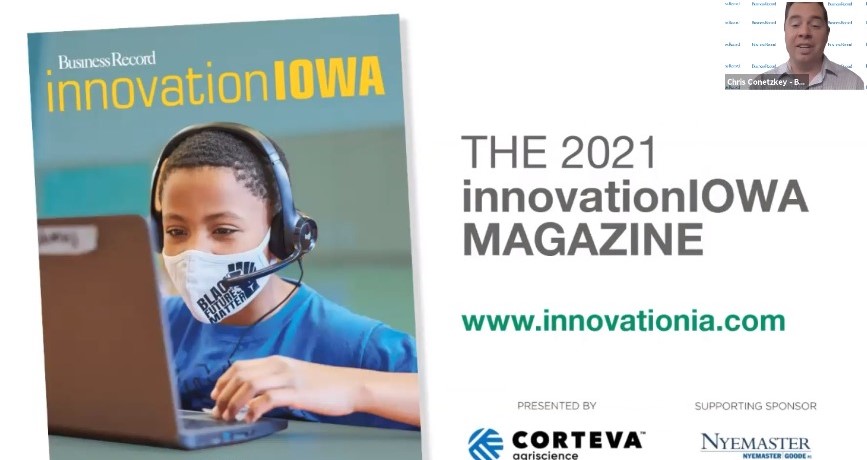In 2020, the Business Record unveiled its annual innovationIOWA Magazine with less than three months to perfect our Zoom events technique. In 2021, we made the Zoom unveiling bigger and brought in four expert panelists to lead a truly statewide forum exploring how companies can support hybrid and fully remote organizations going into the future.
“There’s been a lot of learning, particularly in the health care space, about what does work and what doesn’t,” said Benjamin Lefever, CEO of the healthtech company Certintell Telehealth. “The health care space is responding to that, but you only learn by doing and seeing it fail or be successful in some ways.”
READ MORE: 2021 innovationIOWA MAGAZINE
Below, see how panelists responded to two questions during Thursday’s event. Seeking more? View the full event online, including remarks from our innovationLEADER of the Year BrokerTech Ventures and our innovationENTREPRENEUR of the Year Kevin Maher, and virtual facility tours from Corteva Agriscience.
Panelists:
Joseph Nelson – CEO, Roboflow
Benjamin Lefever – CEO, Certintell Telehealth
Billi Hunt – Executive director, America’s Cultivation Corridor
Mikayla Sullivan – Senior associate, ISA Ventures
How are organizations planning for a distributed workforce, or a return to a central office?
Hunt: That’s a dynamic question, and if I answer it today, it’s probably going to change tomorrow. … I think in the food and agriculture industry, you’re seeing a lot of desire to get people back into the office. All that comes at different cadences depending on how big and how small your organization is.
Over the past year and a half, even the most introverted board member I had couldn’t stop talking when we sat for our board meeting — they were so excited to see people again. We ran a hybrid meeting; I don’t know if we’ll ever go back to “you must be in person.” I think we’re always going to provide those opportunities, because I’d rather have that insight than not have them at a meeting.
Lefever: We’ve seen a big movement where most of our partner organizations in the health care space — hospitals, clinics, organizations — they’ve quickly moved back to in-person. We’ve always been a virtual organization, and so as we continue to expand our team on a clinical side, that’s going to be virtual.
Sullivan: From our perspective as an internal team, there’s a lot of benefits to being spread out across the state. It allows us to connect with founders in different communities instead of being all centralized in one location, so I think we’ll continue to stay hybrid. … From the startup perspective, it just depends on what industry you’re in and what your work looks like.
Nelson: We’ve been exploring what it would be like to have some amount of hybrid [offices] and potentially hubs as we grow the team size even larger. Right now we have employees from Oregon to Washington, D.C. Our critical mass is three employees in Des Moines. … We’re looking at adopting policies like guaranteeing that everyone has a quarterly, on-site meeting. The teams that you work directly with might meet as frequently as every six weeks. … We’re going to continue to experiment as we grow. One thing that’s abundantly clear for us is that a distributed workforce allows you to have access to talent that you wouldn’t have otherwise, and remote work, for us, is not a cost-savings strategy. It’s a way for us to absorb the upside that good talent is everywhere.
What kind of value do remote workforces bring to their communities?
Hunt: I think at the end of the day when someone feels valued in their community — whether that’s small-town Iowa or downtown Des Moines — they give to their community. As we look at economic development, we would love to say, “Hey, we’re bringing in a new company that’s going to hire 500 people.” But that’s really hard today, especially when you look at our unemployment rate. So we have to look a little bit differently at how we grow these companies.
Sullivan: Working from home, you don’t have the commuting time. You have a lot more time in your day to go out into the community and plug in. … Now I can take advantage of going for a run in the morning, exploring the community and plugging into events that are going on.
Nelson: There’s more power for an individual to have other things besides work. … What does the world look like when [work location] is not a requirement anymore? That’s a really good trend, and I think it creates an interesting dynamic for cities.
Tulsa putting out the ability to pay remote workers to come and work there should start an arms race, in a good way, for cities to be attracting talent, and I honestly wish Des Moines and the state of Iowa were more aggressive on this.
Lefever: [Tulsa] is trying to put a community behind these individuals and give them a platform to be engaged within the community, not just have a place to sit and work and get paid $10,000 to move there. From my perspective seeing where health care is going — with telehealth continuing to expand, you’re going to have clinicians all over the country and clinical staff engaging patients in different ways. But even if you’re using a virtual care environment, I do think it’s important to have the clinical team and staff that’s involved in the community, and empower them to do that.
